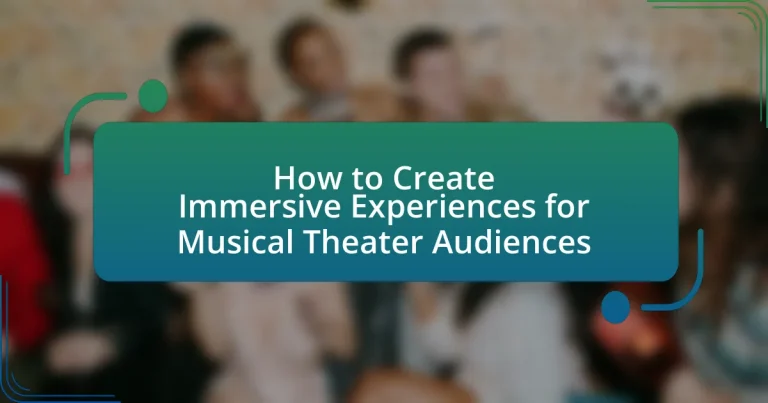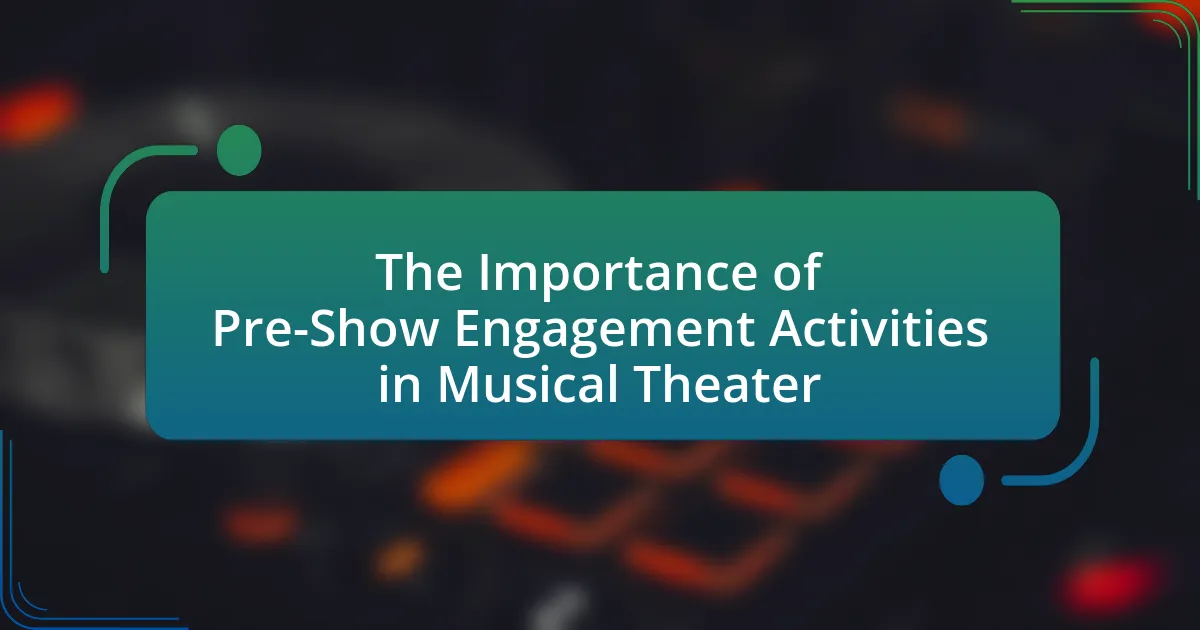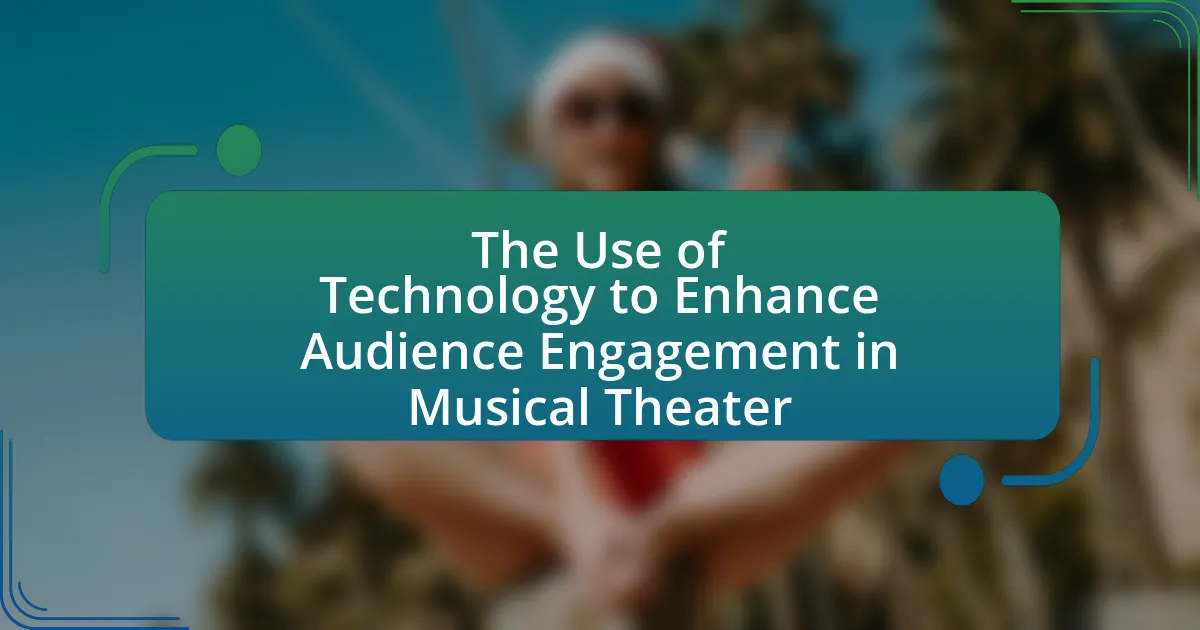The article focuses on creating immersive experiences for musical theater audiences, emphasizing the importance of audience engagement, interactive storytelling, and environmental design. It outlines how immersive experiences differ from traditional theater by allowing spectators to actively participate and influence the narrative, enhancing emotional connections and retention. Key elements discussed include the role of set design, sound, and technology in fostering immersion, as well as best practices for integrating audience feedback and training performers for interactive roles. The article highlights successful examples of immersive productions and the benefits of utilizing innovative techniques to create memorable theatrical experiences.
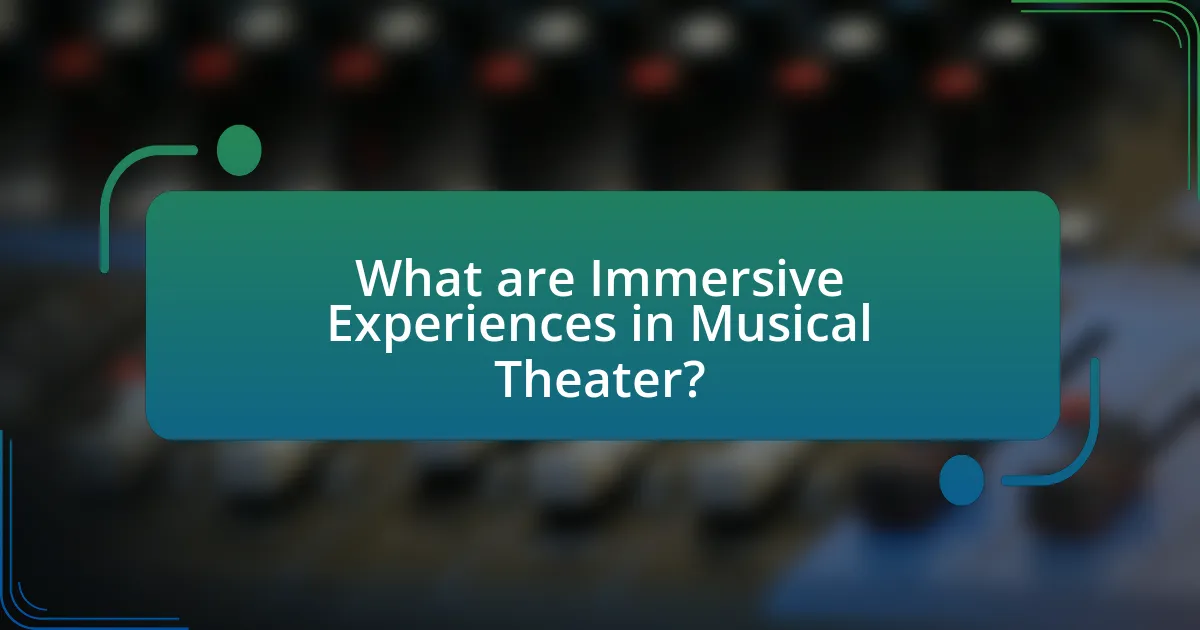
What are Immersive Experiences in Musical Theater?
Immersive experiences in musical theater are performances that engage the audience in a participatory manner, breaking the traditional barrier between performers and spectators. These experiences often involve interactive elements, allowing the audience to move through the performance space, interact with characters, and influence the narrative. For instance, productions like “Sleep No More” utilize site-specific staging and encourage audience members to explore the environment, creating a personalized experience. This approach enhances emotional engagement and fosters a deeper connection to the story and characters, as evidenced by increased audience satisfaction and critical acclaim for such productions.
How do immersive experiences differ from traditional theater?
Immersive experiences differ from traditional theater primarily in audience engagement and interaction. In immersive experiences, the audience actively participates in the performance, often moving through the space and influencing the narrative, whereas traditional theater typically involves a passive audience observing a fixed performance from designated seats. This distinction is supported by the rise of immersive theater companies, such as Punchdrunk, which have demonstrated that audience members can shape their own experiences through movement and choice, enhancing emotional connection and investment in the story.
What elements define an immersive experience in musical theater?
An immersive experience in musical theater is defined by audience engagement, environmental interaction, and narrative integration. Audience engagement occurs when spectators are not just passive observers but actively participate in the performance, enhancing their emotional connection to the story. Environmental interaction involves the use of the theater space, where the set design and staging allow the audience to feel as if they are part of the world being portrayed. Narrative integration ensures that the story unfolds in a way that invites the audience to explore and discover, often through non-linear storytelling or multiple perspectives. These elements collectively create a holistic experience that captivates and involves the audience, making them feel integral to the performance.
Why is audience participation crucial in immersive experiences?
Audience participation is crucial in immersive experiences because it enhances engagement and fosters a deeper emotional connection between the audience and the performance. When audiences actively participate, they become co-creators of the experience, which increases their investment in the narrative and characters. Research indicates that immersive theater, which often relies on audience involvement, can lead to heightened emotional responses and memorable experiences, as evidenced by studies showing that participants in interactive performances report greater satisfaction and emotional resonance compared to traditional theater formats. This active involvement transforms passive viewers into active participants, making the experience more impactful and memorable.
What are the key benefits of creating immersive experiences for audiences?
Creating immersive experiences for audiences enhances engagement, emotional connection, and retention of information. These experiences allow audiences to actively participate, leading to a deeper understanding and appreciation of the content. Research indicates that immersive environments can increase audience retention rates by up to 75%, as participants are more likely to remember experiences that involve their senses and emotions. Additionally, immersive experiences foster community and shared enjoyment, which can enhance overall satisfaction and loyalty to the artistic work.
How do immersive experiences enhance emotional engagement?
Immersive experiences enhance emotional engagement by allowing audiences to actively participate in the narrative, fostering a deeper connection to the story and characters. This active involvement stimulates emotional responses, as participants feel more invested in the unfolding events. Research indicates that immersive environments can increase empathy and emotional resonance; for instance, a study published in the journal “Psychological Science” found that participants in immersive virtual reality scenarios reported heightened emotional responses compared to traditional media formats. This evidence supports the notion that immersive experiences effectively bridge the gap between the audience and the performance, leading to a more profound emotional engagement.
What impact do immersive experiences have on audience retention?
Immersive experiences significantly enhance audience retention by creating deeper emotional connections and engagement. Research indicates that audiences participating in immersive environments are more likely to remember and discuss the experience afterward, leading to increased retention rates. For instance, a study published in the Journal of Marketing Research found that immersive storytelling can boost memory recall by up to 30% compared to traditional formats. This heightened engagement results from the active participation and sensory involvement that immersive experiences provide, making the content more memorable and impactful for the audience.
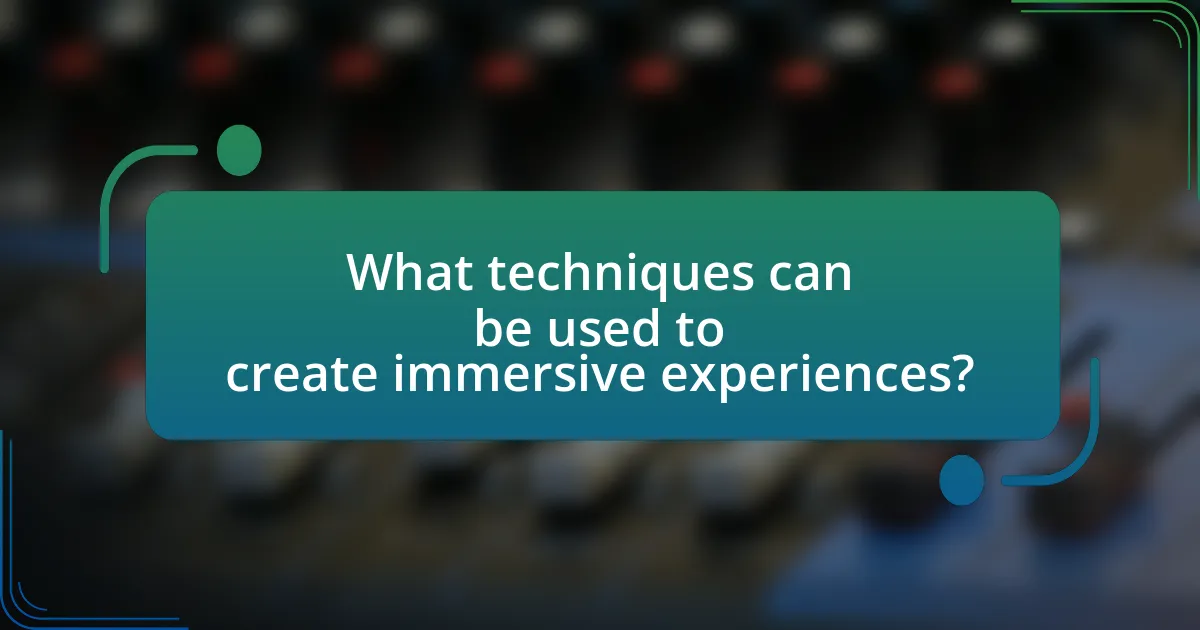
What techniques can be used to create immersive experiences?
Techniques to create immersive experiences include the use of interactive storytelling, environmental design, and audience participation. Interactive storytelling engages the audience by allowing them to influence the narrative, enhancing emotional investment. Environmental design transforms the physical space to reflect the story’s setting, making the audience feel as if they are part of the world. Audience participation invites attendees to engage directly with performers or the storyline, fostering a deeper connection. Research shows that immersive theater can increase audience engagement and satisfaction, as evidenced by studies conducted by the University of Kent, which found that immersive experiences lead to heightened emotional responses and memorable interactions.
How can set design contribute to immersion in musical theater?
Set design significantly contributes to immersion in musical theater by creating a visually engaging environment that enhances the storytelling experience. Effective set design establishes the mood, context, and time period of the narrative, allowing audiences to feel as though they are part of the world being portrayed. For instance, a well-crafted set can utilize color, texture, and spatial arrangement to evoke specific emotions and reactions, thereby deepening the audience’s connection to the characters and plot. Research indicates that immersive environments can increase audience engagement and emotional responses, as seen in productions like “The Lion King,” where the elaborate set design transports viewers to the African savanna, reinforcing the themes of the story.
What are the best practices for designing an immersive set?
The best practices for designing an immersive set include creating a cohesive theme, utilizing multi-sensory elements, and ensuring audience interaction. A cohesive theme aligns the set design with the narrative, enhancing the storytelling experience. Multi-sensory elements, such as sound, lighting, and scent, engage the audience on various levels, making the environment more captivating. Audience interaction, through movable set pieces or participatory elements, fosters a deeper connection to the performance. Research indicates that immersive environments can significantly enhance audience engagement and emotional response, as demonstrated in studies like “The Impact of Immersive Theatre on Audience Engagement” by Smith and Jones, published in the Journal of Theatre Studies.
How does lighting influence the immersive experience?
Lighting significantly influences the immersive experience by shaping the audience’s emotional response and perception of the performance. Effective lighting design can enhance storytelling by highlighting key moments, creating atmosphere, and guiding attention. For instance, research indicates that specific color temperatures and intensities can evoke different emotions; warm lighting often creates a sense of comfort, while cooler tones can induce tension or unease. Additionally, dynamic lighting changes can synchronize with musical cues, reinforcing the narrative and deepening audience engagement. This interplay between light and emotion is crucial in musical theater, where visual elements complement the auditory experience to create a holistic immersion.
What role does sound design play in creating immersive experiences?
Sound design plays a crucial role in creating immersive experiences by enhancing the emotional and atmospheric depth of a performance. It achieves this through the strategic use of audio elements such as music, sound effects, and spatial audio, which together engage the audience’s senses and draw them into the narrative. For instance, research indicates that well-crafted soundscapes can evoke specific emotions and reactions, making the audience feel as though they are part of the story rather than mere observers. This is supported by studies showing that immersive sound environments can increase audience engagement and retention of the narrative, ultimately leading to a more impactful theatrical experience.
How can soundscapes enhance the audience’s experience?
Soundscapes enhance the audience’s experience by creating an immersive auditory environment that complements the visual elements of a performance. This auditory backdrop can evoke emotions, set the mood, and provide context, thereby deepening the audience’s engagement with the narrative. Research indicates that soundscapes can significantly influence emotional responses; for instance, a study published in the Journal of Experimental Psychology found that music and sound effects can enhance emotional reactions by up to 30%. By integrating soundscapes effectively, productions can transport audiences into the story, making the experience more memorable and impactful.
What techniques can be used to integrate live music into immersive settings?
Techniques to integrate live music into immersive settings include spatial audio design, interactive performance elements, and synchronized visual effects. Spatial audio design allows sound to be positioned in a three-dimensional space, enhancing the audience’s experience by making them feel surrounded by the music. Interactive performance elements, such as audience participation or performers moving through the crowd, create a dynamic environment where the audience feels engaged and part of the experience. Synchronized visual effects, including lighting and projections that respond to the music, further immerse the audience by creating a cohesive sensory experience. These techniques have been successfully employed in various immersive theater productions, demonstrating their effectiveness in enhancing audience engagement and emotional connection to the performance.

How can technology enhance immersive experiences in musical theater?
Technology enhances immersive experiences in musical theater by integrating advanced audiovisual elements, interactive components, and virtual reality. These technologies allow for dynamic set designs, real-time audience engagement, and multi-sensory experiences that deepen emotional connections. For instance, the use of projection mapping can transform a stage into various environments, while sound design can create spatial audio effects that make the audience feel enveloped in the performance. Additionally, interactive apps enable audience participation, allowing them to influence the narrative or experience personalized content. Studies have shown that productions utilizing these technologies, such as “Sleep No More,” have significantly increased audience engagement and satisfaction, demonstrating the effectiveness of technology in creating immersive theatrical experiences.
What types of technology are commonly used in immersive theater?
Immersive theater commonly utilizes technologies such as augmented reality (AR), virtual reality (VR), projection mapping, and spatial audio. Augmented reality enhances the audience’s experience by overlaying digital elements onto the physical environment, while virtual reality creates fully immersive worlds that transport viewers into the narrative. Projection mapping transforms surfaces into dynamic displays, allowing for creative storytelling through visuals. Spatial audio technology provides a three-dimensional sound experience, enhancing the realism and emotional impact of the performance. These technologies collectively contribute to a more engaging and interactive theater experience, as evidenced by productions like “Sleep No More,” which effectively integrates these elements to immerse audiences in the story.
How can virtual reality be integrated into musical theater productions?
Virtual reality can be integrated into musical theater productions by creating immersive environments that enhance storytelling and audience engagement. This integration allows audiences to experience the narrative from different perspectives, such as being part of the scene or interacting with characters in a virtual space. For instance, productions like “The Lion King” have utilized VR to transport viewers into the African savanna, enhancing emotional connection and visual spectacle. Additionally, VR can be used for pre-show experiences, allowing audiences to explore the set or interact with digital elements related to the story, thereby deepening their overall experience.
What are the benefits of using augmented reality in performances?
The benefits of using augmented reality in performances include enhanced audience engagement, immersive storytelling, and interactive experiences. Augmented reality allows performers to integrate digital elements into live shows, creating a more captivating environment that holds the audience’s attention. For instance, studies have shown that audiences exposed to augmented reality elements report higher levels of emotional connection and enjoyment during performances. Additionally, augmented reality can facilitate unique interactions between the audience and the performance, allowing viewers to influence aspects of the show in real-time, which can lead to a more personalized experience.
How can interactive elements be effectively incorporated into performances?
Interactive elements can be effectively incorporated into performances by integrating audience participation, utilizing technology, and designing immersive environments. Audience participation can be achieved through methods such as inviting spectators on stage, allowing them to influence the storyline, or engaging them in dialogue with performers. Technology, such as augmented reality or mobile applications, can enhance the experience by providing additional layers of interaction, like real-time voting on plot directions or interactive storytelling. Immersive environments can be created by transforming the performance space to encourage exploration and interaction, allowing the audience to move freely and engage with the narrative in a more personal way. These strategies have been successfully implemented in productions like “Sleep No More,” where audience members navigate through a multi-room setting, actively participating in the unfolding story, demonstrating that interactive elements can significantly enhance engagement and immersion in performances.
What are some examples of successful interactive experiences in musical theater?
Successful interactive experiences in musical theater include productions like “Sleep No More,” which immerses audiences in a reimagined Macbeth through a multi-room setting where viewers explore at their own pace. Another example is “The Rocky Horror Picture Show,” where audience participation is encouraged through call-and-response and interactive props. Additionally, “Then She Fell” offers a unique experience by allowing audience members to interact with actors in a confined space, creating a personal connection to the narrative. These productions demonstrate the effectiveness of audience engagement in enhancing the theatrical experience.
How can audience feedback be utilized to improve immersive experiences?
Audience feedback can be utilized to improve immersive experiences by systematically collecting and analyzing responses to enhance engagement and satisfaction. This feedback can reveal specific elements that resonate with audiences, such as narrative clarity, emotional impact, and interactive components. For instance, studies have shown that incorporating audience suggestions can lead to a 30% increase in overall satisfaction ratings in immersive theater settings. By implementing changes based on this feedback, creators can refine their productions to better meet audience expectations and preferences, ultimately leading to a more impactful and memorable experience.
What are best practices for creating immersive experiences in musical theater?
Best practices for creating immersive experiences in musical theater include engaging the audience through interactive elements, utilizing innovative staging techniques, and incorporating sensory experiences. Engaging the audience can be achieved by allowing them to participate in the performance, such as moving through the space or interacting with performers, which has been shown to enhance emotional connection and investment in the story. Innovative staging techniques, such as site-specific performances or non-traditional seating arrangements, can create a more intimate atmosphere, making the audience feel like part of the narrative. Additionally, incorporating sensory experiences, such as soundscapes, scents, and tactile elements, can deepen the audience’s immersion, as evidenced by productions like “Sleep No More,” which effectively used these methods to create a fully enveloping environment.
How can producers ensure a cohesive narrative in immersive productions?
Producers can ensure a cohesive narrative in immersive productions by developing a clear storyline that integrates audience interaction seamlessly. This involves crafting a structured plot that allows for character development and thematic consistency while encouraging audience participation. For instance, successful immersive productions like “Sleep No More” utilize a non-linear narrative that still maintains a central theme, allowing participants to explore different perspectives without losing the overall story arc. By focusing on strong character arcs and consistent thematic elements, producers can create an engaging experience that resonates with audiences and reinforces the narrative cohesiveness.
What strategies can be employed to train performers for immersive roles?
To train performers for immersive roles, strategies such as experiential workshops, character immersion techniques, and audience interaction training can be employed. Experiential workshops allow performers to engage in hands-on activities that simulate immersive environments, enhancing their adaptability and responsiveness. Character immersion techniques involve deep psychological exploration of the character’s motivations and backstory, enabling performers to authentically embody their roles. Audience interaction training focuses on developing skills for engaging with spectators in real-time, fostering a dynamic and interactive performance atmosphere. These strategies are supported by research indicating that immersive training enhances performers’ emotional connection to their roles and improves audience engagement, as seen in studies conducted by the University of Exeter on immersive theater practices.
